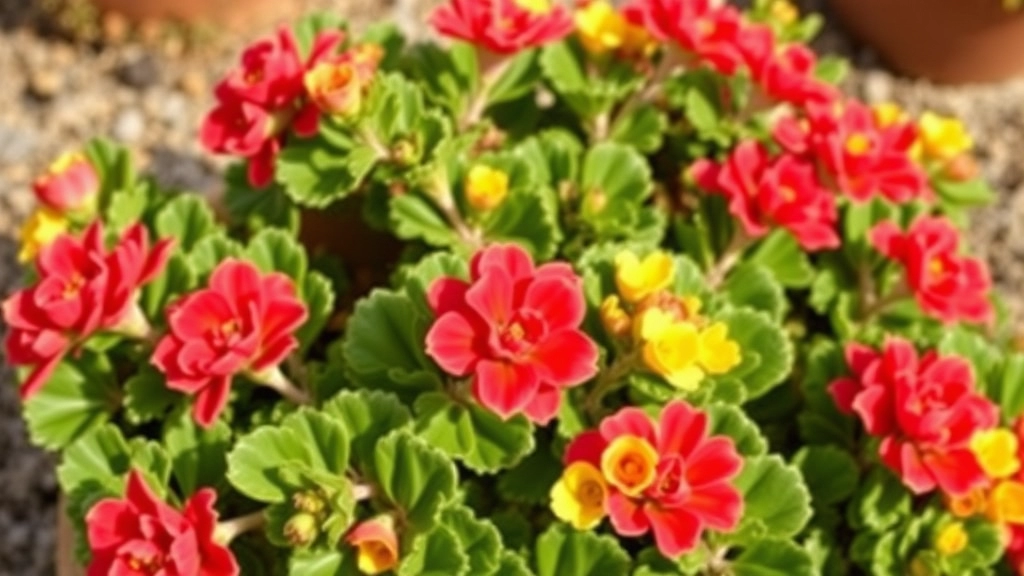Pruning Leggy Kalanchoe
Pruning leggy Kalanchoe can seem daunting, but with the right approach, you can revive your plant and restore its bushy charm. I’ve been there, staring at those overgrown stems, wondering where to start. But trust me, with a few simple steps, you can transform your Kalanchoe back into a lush, vibrant beauty.
Gather Your Tools
First, gather your tools: a pair of sharp pruning shears and some gloves. The best time to prune is during the growing season, typically in spring or early summer.
Steps to Prune Your Kalanchoe
- Start by cutting back the leggy stems, making clean cuts just above a leaf node.
- Don’t forget to shape the plant as you go, aiming for a fuller appearance.
- Pinching off growth tips can also encourage bushier growth.
And remember, proper lighting and watering are key to preventing future legginess. Happy pruning!
Tools You Need to Prune Your Leggy Kalanchoe
When it comes to pruning your leggy Kalanchoe, having the right tools can make all the difference. You might wonder what exactly you need to get started. Let’s dive into the essential tools that will ensure a smooth pruning process.
Essential Tools for Pruning Kalanchoe
- Sharp Pruning Shears
- A clean cut is crucial for plant health.
- Ensure your shears are sharp to prevent tearing the stems.
- Gardening Gloves
- Protect your hands from potential irritants.
- Gloves also provide a better grip on your tools.
- Disinfectant
- A simple solution of rubbing alcohol or bleach can help prevent the spread of disease.
- Always disinfect your shears before and after use.
- Small Trowel
- Useful for removing soil if you plan to re-pot after pruning.
- Helps in accessing the base of the plant easily.
- Container for Cuttings
- If you plan to propagate, have a container ready for your cuttings.
- This keeps them safe while you work.
- Watering Can
- After pruning, your plant may need a drink.
- Ensure you use a can with a fine spout to avoid overwatering.
Having these tools on hand will streamline your pruning session, making it less of a chore and more of a rewarding experience. For more detailed guidance, check out our complete guide on caring for Kalanchoe after flowering and learn about the step-by-step process for Kalanchoe leaf propagation.
Best Time to Prune Kalanchoe for Optimal Results
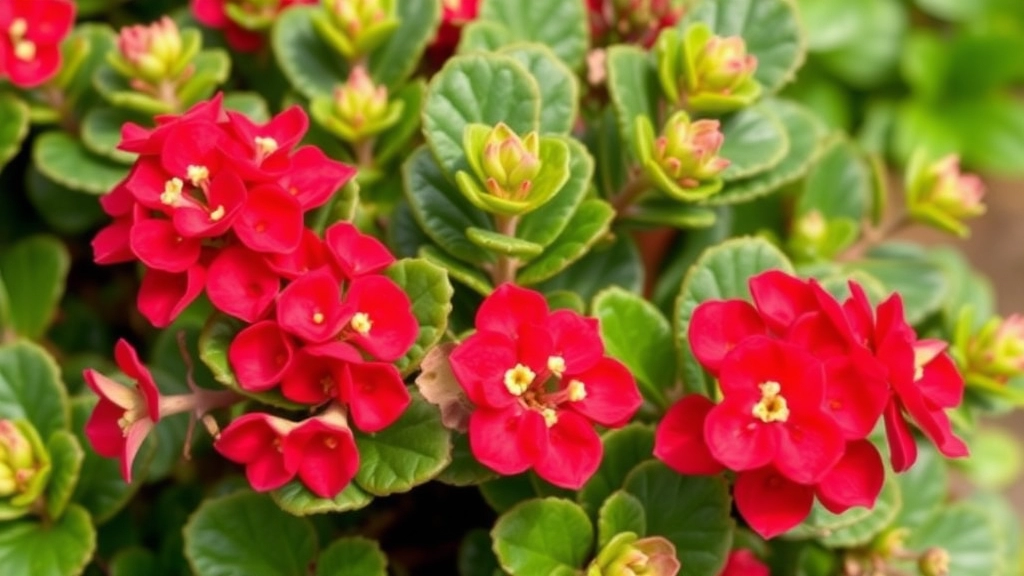
So, you’re wondering when’s the best time to give your leggy Kalanchoe a little trim, right?
Timing is everything when it comes to pruning.
Ideal Seasons for Pruning:
- Spring: This is the golden time! As the days get longer and warmer, your Kalanchoe is gearing up for a growth spurt. Pruning in spring encourages new growth and helps the plant bounce back quickly.
- Late Summer: If you missed the spring window, late summer is another good option. Just be cautious—pruning too late can stress the plant as it heads into dormancy.
Signs It’s Time to Prune:
- Legginess: If your Kalanchoe is stretching towards the light and looking a bit sad, it’s definitely time for a haircut.
- Overcrowding: If your plant is getting too bushy and crowded, a trim can help it breathe and thrive.
Things to Avoid:
- Don’t Prune in Winter: Kalanchoes are resting during this time. Pruning can hinder their natural cycle and lead to stress.
- Avoid Pruning During Flowering: If your plant is in bloom, hold off on the scissors. You want to enjoy those flowers!
Step-by-Step Guide to Cutting Back Leggy Stems
If you’ve noticed that your Kalanchoe has become leggy, you might be wondering how to effectively cut back those stems for a healthier plant.
Here’s a straightforward guide to help you through the process:
- Gather Your Tools
– Sharp, clean pruning shears or scissors
– Rubbing alcohol for sanitising
– A small container for cuttings - Prepare Your Workspace
– Choose a clean, well-lit area to work in.
– Lay down some newspaper or a cloth to catch any debris. - Assess the Plant
– Look for stems that are excessively long or have lost their leaves.
– Identify any dead or unhealthy sections that need removal. - Sanitise Your Tools
– Wipe the blades with rubbing alcohol to prevent any disease transmission. - Make Your Cuts
– Cut back the leggy stems to just above a leaf node.
– Aim for a 1/4 inch above the node to encourage new growth.
– Remove any dead or yellowing leaves to promote overall plant health. - Trim for Shape
– If your Kalanchoe is uneven, trim additional stems to create a balanced appearance.
– Focus on maintaining a symmetrical shape for aesthetic appeal. - Dispose of Cuttings
– Place the cuttings in your container or compost them if they are healthy. - Clean Up
– Dispose of any debris and sanitise your workspace to prevent pests.
For more detailed care tips, check out our complete care guide for Kalanchoe Flapjack and learn how to properly maintain your plant. Additionally, if you are interested in propagation, our step-by-step guide on propagating Kalanchoe Pink Butterflies can be very helpful.
Shaping the Kalanchoe for a Fuller Appearance
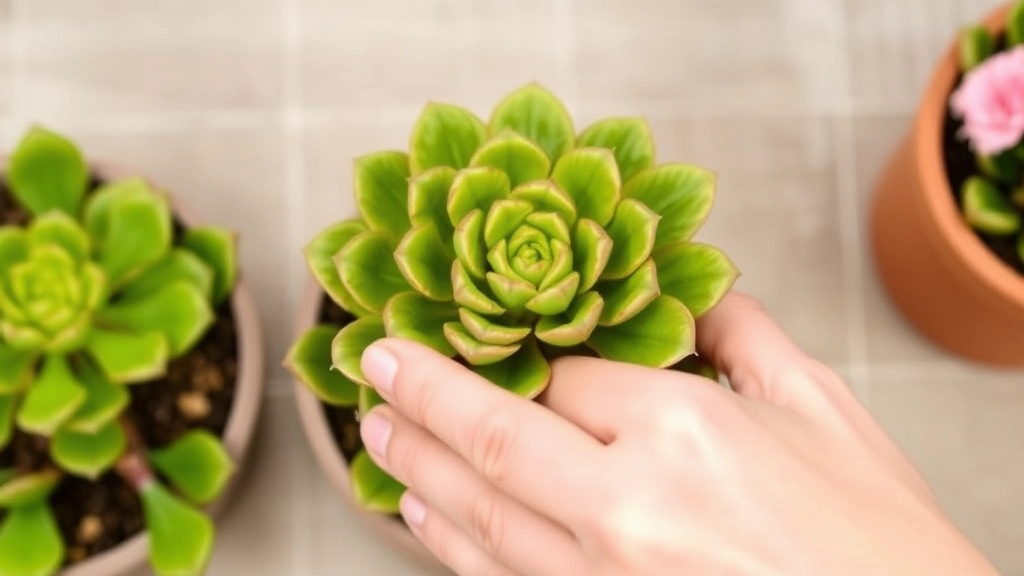
After addressing the legginess of your Kalanchoe, the next step is to shape it for a fuller appearance. Many plant enthusiasts worry about how to achieve a bushy look, and it’s easier than you might think.
Why Shape Your Kalanchoe?
Shaping your Kalanchoe not only enhances its visual appeal but also promotes healthy growth. A well-shaped plant can better absorb light and nutrients, leading to a more vibrant display.
Techniques for Shaping Your Kalanchoe:
- Cut Back Long Stems:
- Identify the longer, leggy stems.
- Trim them back to just above a leaf node to encourage new growth.
- Encourage Lateral Growth:
- Focus on cutting stems that are growing straight up.
- This will promote branching and help the plant fill out.
- Maintain Balance:
- Ensure that you’re shaping the plant evenly.
- Step back occasionally to assess the overall shape.
- Use Clean Tools:
- Always use sharp, sterilised scissors or pruning shears.
- This helps prevent disease and ensures clean cuts.
- Remove Dead or Yellowing Leaves:
- Regularly check for any unhealthy foliage.
- Removing these can redirect energy to healthier parts of the plant.
By following these techniques, you’ll be well on your way to achieving a fuller, bushier Kalanchoe.
How to Pinch Off Growth Tips to Encourage Bushier Growth
If you’ve been struggling with a leggy Kalanchoe, you’re not alone. Many plant enthusiasts face the challenge of promoting fuller growth in their succulents. One effective method to achieve this is by pinching off growth tips, a simple yet impactful technique.
Why Pinch Off Growth Tips?
Pinching off the growth tips encourages the plant to focus its energy on producing lateral branches rather than just growing taller. This results in a bushier, more compact Kalanchoe.
Proper Lighting Conditions to Prevent Future Legginess
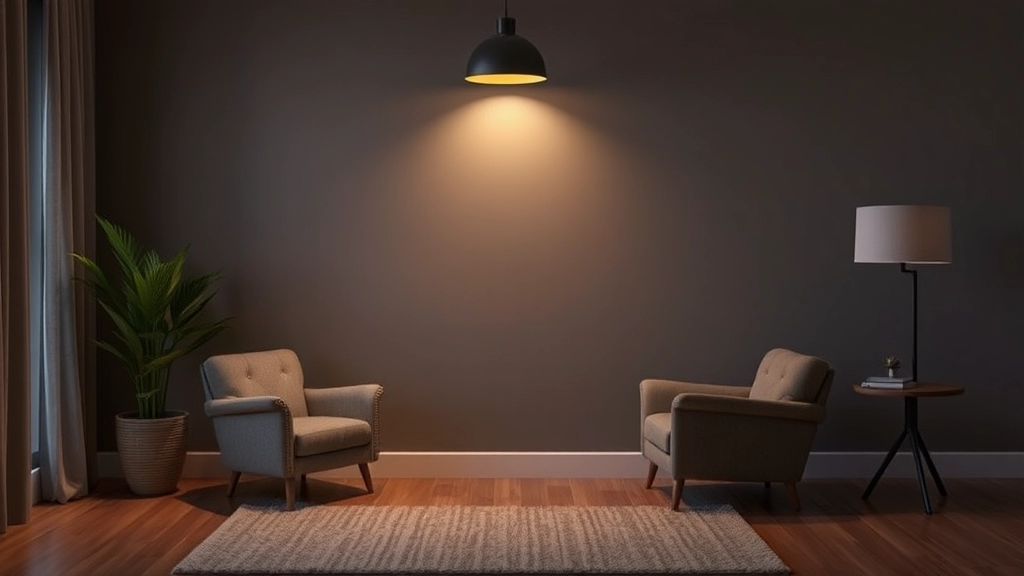
Have you ever looked at your Kalanchoe and thought, “Why is it so leggy?” Trust me, you’re not alone in this!
One of the biggest culprits behind leggy growth is inadequate lighting. If your plant isn’t getting enough light, it’ll stretch out, reaching for those rays like a kid reaching for cookies on the top shelf.
Here’s how to ensure your Kalanchoe gets the right light:
- Bright, Indirect Light: Kalanchoes thrive in bright, indirect sunlight. A south or east-facing window is usually a winner.
- Rotate Regularly: If your plant is leaning towards the light source, give it a gentle twist every couple of weeks. This helps it grow evenly and prevents one-sided legginess.
- Avoid Direct Sun: While they love light, too much direct sun can scorch those lovely leaves. Keep an eye out for any browning tips.
- Supplement with Grow Lights: If natural light is lacking, especially in winter, consider using grow lights. They mimic sunlight and can help keep your Kalanchoe happy.
- Watch for Signs: If you notice your plant stretching again, it’s time to reassess its lighting situation.
Watering and Soil Drainage Tips to Maintain Plant Health
Maintaining the health of your Kalanchoe is essential, especially after pruning. One of the key aspects to focus on is the watering and soil drainage. You might be wondering how to strike the right balance.
Fertilization Practices to Support Post-Pruning Recovery
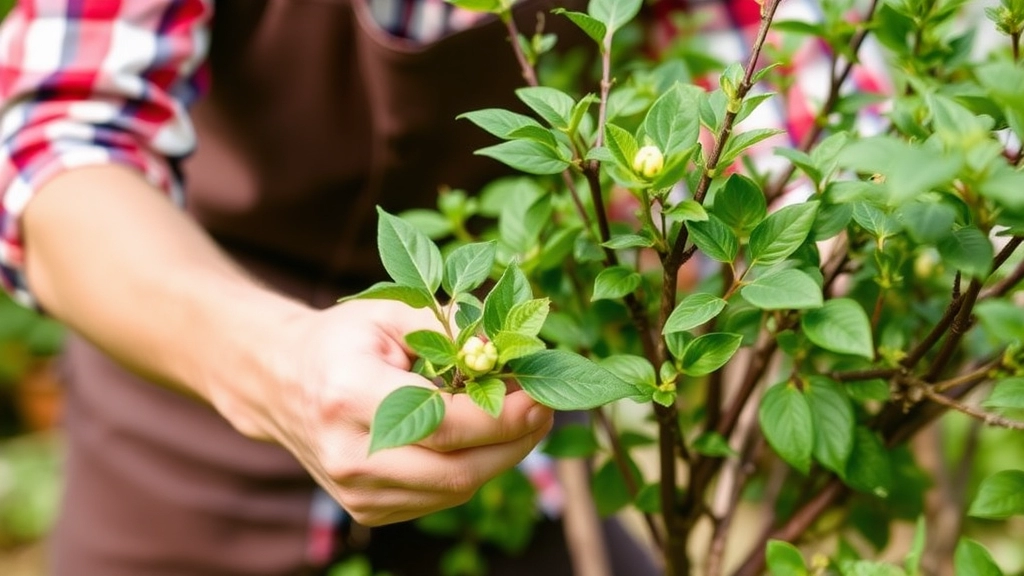
So, you’ve just pruned your leggy Kalanchoe and are feeling pretty good about it. But what’s next? How do you make sure your plant bounces back stronger and bushier than ever?
Fertilization is key.
After pruning, your Kalanchoe will need a little extra love to recover and thrive. Here’s how to give it the boost it needs:
- Use a Balanced Fertilizer: A balanced, water-soluble fertilizer (like a 10-10-10) is great for post-pruning recovery. This means the nutrients are evenly distributed, helping your plant get what it needs across the board.
- Dilute the Fertilizer: Don’t go full throttle right away. Dilute the fertilizer to half the recommended strength. This prevents any shock to the roots while still providing essential nutrients.
- Timing is Everything: Wait about two weeks after pruning before applying fertilizer. This gives your Kalanchoe time to recover from the cut and start focusing on new growth.
- Frequency: Fertilize every 4-6 weeks during the growing season (spring and summer) for the best results.
- Monitor Your Plant: Keep an eye on your Kalanchoe’s response. If you see new growth, you’re on the right track!
By giving your Kalanchoe the right nutrients after pruning, you’re setting the stage for healthy growth.
After pruning your leggy Kalanchoe, you might wonder how to ensure it thrives in its new form. Proper post-pruning care is essential for monitoring new growth and fostering a healthy plant.
Key Steps for Post-Pruning Care
– **Observation**: Check your plant regularly for signs of new growth. Look for fresh leaves and stems emerging from the cut areas.
– **Watering**: Allow the soil to dry out slightly between waterings. Overwatering can lead to root rot, especially after pruning.
– **Light Conditions**: Ensure your Kalanchoe receives adequate light. A bright spot with indirect sunlight is ideal for stimulating growth without causing stress.
– **Temperature**: Keep the plant in a stable environment, ideally between 15°C and 25°C. Sudden temperature changes can hinder recovery.
– **Humidity**: Maintain moderate humidity levels. If your home is dry, consider misting the plant occasionally.
Fertilisation
– **Nutrient Boost**: About four weeks after pruning, apply a balanced, diluted fertiliser to encourage robust new growth.
– **Frequency**: Fertilise every four to six weeks during the growing season for optimal results.
New growth may take some time to appear. Be patient and continue to provide the care your Kalanchoe needs. For more detailed tips, you can refer to the [Florist Kalanchoe Pruning: Essential Tips for Optimal Growth](https://planthq.org/florist-kalanchoe-pruning-essential-tips-for-optimal-growth/) guide. Additionally, understanding [Why Your Non-Flowering Kalanchoe Isn’t Blooming](https://planthq.org/why-your-non-flowering-kalanchoe-isnt-blooming-tips-fixes/) can provide insights into ensuring your plant remains healthy and vibrant.
Propagating Kalanchoe from Pruned Cuttings
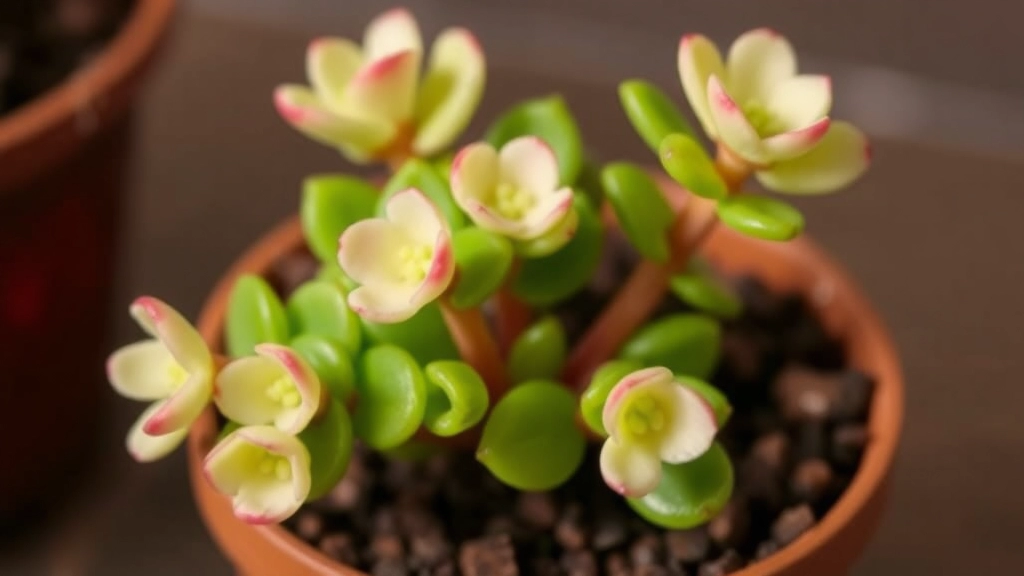
So, you’ve just pruned your leggy Kalanchoe, and now you’re left with those lovely cuttings.
What to do with them?
Well, you can turn those pruned bits into new plants!
Here’s how to propagate Kalanchoe from those cuttings, making the most out of your gardening efforts.
Steps for Propagation
- Choose Healthy Cuttings: Look for stems that are healthy and at least 3-4 inches long. Avoid any that are wilted or damaged.
- Let Them Callous: Place the cuttings in a dry, warm spot for a few days. This helps the cut ends to callous over, reducing the risk of rot when you plant them.
- Use Well-Draining Soil: Grab a small pot and fill it with a cactus or succulent mix. This type of soil drains well and keeps your cuttings happy.
- Plant the Cuttings: Stick the calloused end of each cutting into the soil, burying it about an inch deep.
- Water Sparingly: Give them a light misting but avoid soaking the soil. Too much water can lead to rot.
- Provide Bright, Indirect Light: Place your pot in a spot with plenty of indirect sunlight. This helps the cuttings root without stressing them out.
- Be Patient: It can take a few weeks for roots to develop. Keep an eye on them and don’t rush the process!
Why Propagation is a Win-Win
Not only do you get to rescue those pruned pieces, but you also expand your plant collection without spending a penny.
Plus, it’s a fun way to share plants with friends or even trade for other varieties!
Common Mistakes to Avoid When Pruning Kalanchoe
Pruning your leggy Kalanchoe can be a rewarding experience, but it’s easy to make mistakes that can hinder your plant’s growth.
Here are some common pitfalls to watch out for:
- Cutting Too Much at Once: Avoid the temptation to take off large sections of the plant. This can shock the Kalanchoe and lead to stunted growth. Instead, prune gradually, focusing on a few stems at a time.
- Ignoring Clean Tools: Using dirty scissors or shears can introduce diseases to your plant. Always ensure your tools are clean and sterilised before making any cuts.
- Pruning at the Wrong Time: Timing is crucial. Pruning during the plant’s dormant period can lead to poor recovery. Aim to prune during the growing season for optimal results.
- Neglecting to Assess Plant Health: Before pruning, check for signs of pests or disease. Pruning a stressed plant can exacerbate existing problems.
- Forgetting About Light Conditions: After pruning, ensure your Kalanchoe is receiving adequate light. Poor lighting can lead to further legginess.
- Overlooking Post-Pruning Care: After cutting back, many forget to adjust their care routine. Ensure you monitor watering and provide the right nutrients to support recovery.
For more detailed advice on pruning and maintaining your Kalanchoe, check out our guide on pruning and care tips for overgrown Kalanchoe. Additionally, if you’re interested in understanding the best practices for overall Kalanchoe plant care, we have a comprehensive guide available.
FAQs on Pruning Leggy Kalanchoe
When is the best time to prune my leggy Kalanchoe?
The ideal times to prune your Kalanchoe are in the spring and late summer. Spring is the best time as the plant is gearing up for a growth spurt. If you miss the spring window, late summer is another good option, but avoid pruning too late in the season to prevent stressing the plant as it heads into dormancy.
What are the signs that my Kalanchoe needs pruning?
Look for signs of legginess, where the plant stretches towards the light and looks sparse. Overcrowding is another indicator, where the plant becomes too bushy and crowded, needing a trim to breathe and thrive.
What should I avoid when pruning my Kalanchoe?
Avoid pruning during winter as the plant is resting and pruning can hinder its natural cycle. Also, refrain from pruning during flowering to enjoy the blooms fully.
FAQs on Shaping Kalanchoe for a Fuller Appearance
Why should I shape my Kalanchoe?
Shaping your Kalanchoe enhances its visual appeal and promotes healthy growth. A well-shaped plant can better absorb light and nutrients, leading to a more vibrant display.
What techniques can I use to shape my Kalanchoe?
Techniques include cutting back long stems, encouraging lateral growth, maintaining balance, using clean tools, and removing dead or yellowing leaves. These steps help achieve a fuller, bushier appearance.
FAQs on Proper Lighting Conditions to Prevent Legginess
What lighting conditions are best for my Kalanchoe?
Kalanchoes thrive in bright, indirect sunlight. A south or east-facing window is ideal. Rotate the plant regularly to ensure even growth and avoid direct sunlight to prevent leaf scorching.
Can I use grow lights for my Kalanchoe?
Yes, if natural light is lacking, especially in winter, consider using grow lights to mimic sunlight and keep your Kalanchoe happy.
FAQs on Fertilization Practices Post-Pruning
How should I fertilize my Kalanchoe after pruning?
Use a balanced, water-soluble fertilizer diluted to half the recommended strength about two weeks after pruning. Fertilize every 4-6 weeks during the growing season (spring and summer) to support new growth.
Why is fertilization important after pruning?
Fertilization provides the essential nutrients needed for the plant to recover and thrive, promoting healthy new growth and a stronger plant overall.
FAQs on Propagating Kalanchoe from Pruned Cuttings
How can I propagate Kalanchoe from pruned cuttings?
Choose healthy cuttings, let them callous, use well-draining soil, plant the cuttings, water sparingly, provide bright, indirect light, and be patient. These steps will help you successfully propagate new Kalanchoe plants.
What are the benefits of propagating Kalanchoe?
Propagation allows you to expand your plant collection without spending money and offers the opportunity to share plants with friends or trade for other varieties. It’s a rewarding way to make the most of your gardening efforts.
References
-
Gardening Know How – Kalanchoe Pruning Tips
-
The Spruce – How to Prune Kalanchoe
-
Houseplant411 – Kalanchoe Care Guide
